Anil Kag
Taming Diffusion Transformer for Real-Time Mobile Video Generation
Jul 17, 2025Abstract:Diffusion Transformers (DiT) have shown strong performance in video generation tasks, but their high computational cost makes them impractical for resource-constrained devices like smartphones, and real-time generation is even more challenging. In this work, we propose a series of novel optimizations to significantly accelerate video generation and enable real-time performance on mobile platforms. First, we employ a highly compressed variational autoencoder (VAE) to reduce the dimensionality of the input data without sacrificing visual quality. Second, we introduce a KD-guided, sensitivity-aware tri-level pruning strategy to shrink the model size to suit mobile platform while preserving critical performance characteristics. Third, we develop an adversarial step distillation technique tailored for DiT, which allows us to reduce the number of inference steps to four. Combined, these optimizations enable our model to achieve over 10 frames per second (FPS) generation on an iPhone 16 Pro Max, demonstrating the feasibility of real-time, high-quality video generation on mobile devices.
H3AE: High Compression, High Speed, and High Quality AutoEncoder for Video Diffusion Models
Apr 14, 2025Abstract:Autoencoder (AE) is the key to the success of latent diffusion models for image and video generation, reducing the denoising resolution and improving efficiency. However, the power of AE has long been underexplored in terms of network design, compression ratio, and training strategy. In this work, we systematically examine the architecture design choices and optimize the computation distribution to obtain a series of efficient and high-compression video AEs that can decode in real time on mobile devices. We also unify the design of plain Autoencoder and image-conditioned I2V VAE, achieving multifunctionality in a single network. In addition, we find that the widely adopted discriminative losses, i.e., GAN, LPIPS, and DWT losses, provide no significant improvements when training AEs at scale. We propose a novel latent consistency loss that does not require complicated discriminator design or hyperparameter tuning, but provides stable improvements in reconstruction quality. Our AE achieves an ultra-high compression ratio and real-time decoding speed on mobile while outperforming prior art in terms of reconstruction metrics by a large margin. We finally validate our AE by training a DiT on its latent space and demonstrate fast, high-quality text-to-video generation capability.
Towards Physical Understanding in Video Generation: A 3D Point Regularization Approach
Feb 05, 2025Abstract:We present a novel video generation framework that integrates 3-dimensional geometry and dynamic awareness. To achieve this, we augment 2D videos with 3D point trajectories and align them in pixel space. The resulting 3D-aware video dataset, PointVid, is then used to fine-tune a latent diffusion model, enabling it to track 2D objects with 3D Cartesian coordinates. Building on this, we regularize the shape and motion of objects in the video to eliminate undesired artifacts, \eg, nonphysical deformation. Consequently, we enhance the quality of generated RGB videos and alleviate common issues like object morphing, which are prevalent in current video models due to a lack of shape awareness. With our 3D augmentation and regularization, our model is capable of handling contact-rich scenarios such as task-oriented videos. These videos involve complex interactions of solids, where 3D information is essential for perceiving deformation and contact. Furthermore, our model improves the overall quality of video generation by promoting the 3D consistency of moving objects and reducing abrupt changes in shape and motion.
SnapGen-V: Generating a Five-Second Video within Five Seconds on a Mobile Device
Dec 13, 2024Abstract:We have witnessed the unprecedented success of diffusion-based video generation over the past year. Recently proposed models from the community have wielded the power to generate cinematic and high-resolution videos with smooth motions from arbitrary input prompts. However, as a supertask of image generation, video generation models require more computation and are thus hosted mostly on cloud servers, limiting broader adoption among content creators. In this work, we propose a comprehensive acceleration framework to bring the power of the large-scale video diffusion model to the hands of edge users. From the network architecture scope, we initialize from a compact image backbone and search out the design and arrangement of temporal layers to maximize hardware efficiency. In addition, we propose a dedicated adversarial fine-tuning algorithm for our efficient model and reduce the denoising steps to 4. Our model, with only 0.6B parameters, can generate a 5-second video on an iPhone 16 PM within 5 seconds. Compared to server-side models that take minutes on powerful GPUs to generate a single video, we accelerate the generation by magnitudes while delivering on-par quality.
SnapGen: Taming High-Resolution Text-to-Image Models for Mobile Devices with Efficient Architectures and Training
Dec 12, 2024Abstract:Existing text-to-image (T2I) diffusion models face several limitations, including large model sizes, slow runtime, and low-quality generation on mobile devices. This paper aims to address all of these challenges by developing an extremely small and fast T2I model that generates high-resolution and high-quality images on mobile platforms. We propose several techniques to achieve this goal. First, we systematically examine the design choices of the network architecture to reduce model parameters and latency, while ensuring high-quality generation. Second, to further improve generation quality, we employ cross-architecture knowledge distillation from a much larger model, using a multi-level approach to guide the training of our model from scratch. Third, we enable a few-step generation by integrating adversarial guidance with knowledge distillation. For the first time, our model SnapGen, demonstrates the generation of 1024x1024 px images on a mobile device around 1.4 seconds. On ImageNet-1K, our model, with only 372M parameters, achieves an FID of 2.06 for 256x256 px generation. On T2I benchmarks (i.e., GenEval and DPG-Bench), our model with merely 379M parameters, surpasses large-scale models with billions of parameters at a significantly smaller size (e.g., 7x smaller than SDXL, 14x smaller than IF-XL).
AsCAN: Asymmetric Convolution-Attention Networks for Efficient Recognition and Generation
Nov 07, 2024
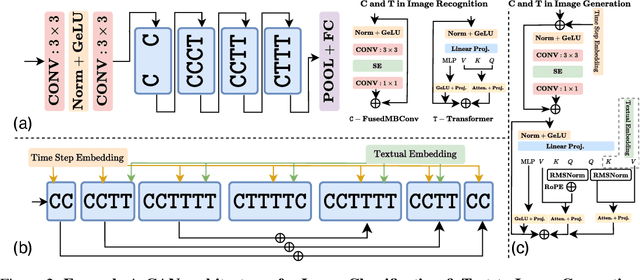
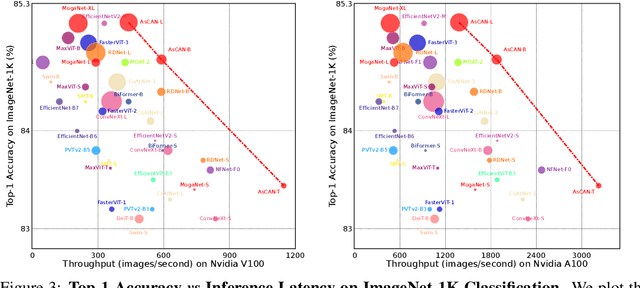

Abstract:Neural network architecture design requires making many crucial decisions. The common desiderata is that similar decisions, with little modifications, can be reused in a variety of tasks and applications. To satisfy that, architectures must provide promising latency and performance trade-offs, support a variety of tasks, scale efficiently with respect to the amounts of data and compute, leverage available data from other tasks, and efficiently support various hardware. To this end, we introduce AsCAN -- a hybrid architecture, combining both convolutional and transformer blocks. We revisit the key design principles of hybrid architectures and propose a simple and effective \emph{asymmetric} architecture, where the distribution of convolutional and transformer blocks is \emph{asymmetric}, containing more convolutional blocks in the earlier stages, followed by more transformer blocks in later stages. AsCAN supports a variety of tasks: recognition, segmentation, class-conditional image generation, and features a superior trade-off between performance and latency. We then scale the same architecture to solve a large-scale text-to-image task and show state-of-the-art performance compared to the most recent public and commercial models. Notably, even without any computation optimization for transformer blocks, our models still yield faster inference speed than existing works featuring efficient attention mechanisms, highlighting the advantages and the value of our approach.
Scalable Ranked Preference Optimization for Text-to-Image Generation
Oct 23, 2024
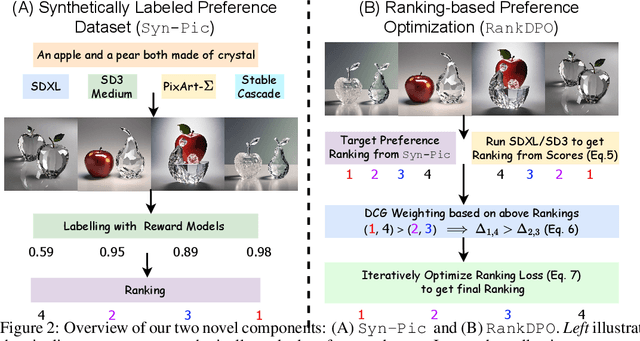

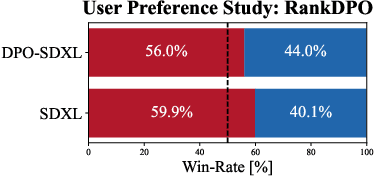
Abstract:Direct Preference Optimization (DPO) has emerged as a powerful approach to align text-to-image (T2I) models with human feedback. Unfortunately, successful application of DPO to T2I models requires a huge amount of resources to collect and label large-scale datasets, e.g., millions of generated paired images annotated with human preferences. In addition, these human preference datasets can get outdated quickly as the rapid improvements of T2I models lead to higher quality images. In this work, we investigate a scalable approach for collecting large-scale and fully synthetic datasets for DPO training. Specifically, the preferences for paired images are generated using a pre-trained reward function, eliminating the need for involving humans in the annotation process, greatly improving the dataset collection efficiency. Moreover, we demonstrate that such datasets allow averaging predictions across multiple models and collecting ranked preferences as opposed to pairwise preferences. Furthermore, we introduce RankDPO to enhance DPO-based methods using the ranking feedback. Applying RankDPO on SDXL and SD3-Medium models with our synthetically generated preference dataset ``Syn-Pic'' improves both prompt-following (on benchmarks like T2I-Compbench, GenEval, and DPG-Bench) and visual quality (through user studies). This pipeline presents a practical and scalable solution to develop better preference datasets to enhance the performance of text-to-image models.
Lightweight Predictive 3D Gaussian Splats
Jun 27, 2024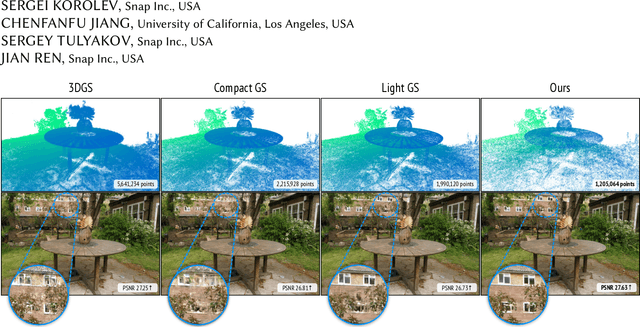

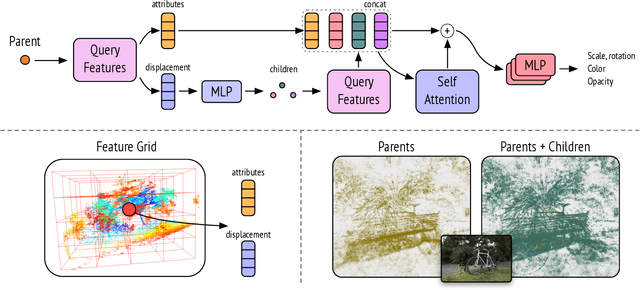

Abstract:Recent approaches representing 3D objects and scenes using Gaussian splats show increased rendering speed across a variety of platforms and devices. While rendering such representations is indeed extremely efficient, storing and transmitting them is often prohibitively expensive. To represent large-scale scenes, one often needs to store millions of 3D Gaussians, occupying gigabytes of disk space. This poses a very practical limitation, prohibiting widespread adoption.Several solutions have been proposed to strike a balance between disk size and rendering quality, noticeably reducing the visual quality. In this work, we propose a new representation that dramatically reduces the hard drive footprint while featuring similar or improved quality when compared to the standard 3D Gaussian splats. When compared to other compact solutions, ours offers higher quality renderings with significantly reduced storage, being able to efficiently run on a mobile device in real-time. Our key observation is that nearby points in the scene can share similar representations. Hence, only a small ratio of 3D points needs to be stored. We introduce an approach to identify such points which are called parent points. The discarded points called children points along with attributes can be efficiently predicted by tiny MLPs.
BitsFusion: 1.99 bits Weight Quantization of Diffusion Model
Jun 06, 2024

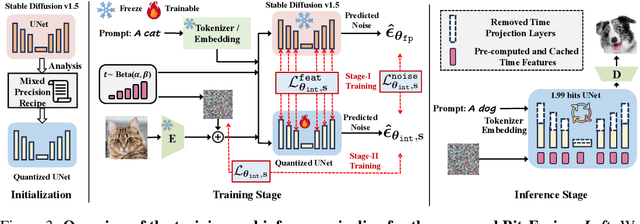

Abstract:Diffusion-based image generation models have achieved great success in recent years by showing the capability of synthesizing high-quality content. However, these models contain a huge number of parameters, resulting in a significantly large model size. Saving and transferring them is a major bottleneck for various applications, especially those running on resource-constrained devices. In this work, we develop a novel weight quantization method that quantizes the UNet from Stable Diffusion v1.5 to 1.99 bits, achieving a model with 7.9X smaller size while exhibiting even better generation quality than the original one. Our approach includes several novel techniques, such as assigning optimal bits to each layer, initializing the quantized model for better performance, and improving the training strategy to dramatically reduce quantization error. Furthermore, we extensively evaluate our quantized model across various benchmark datasets and through human evaluation to demonstrate its superior generation quality.
SF-V: Single Forward Video Generation Model
Jun 06, 2024Abstract:Diffusion-based video generation models have demonstrated remarkable success in obtaining high-fidelity videos through the iterative denoising process. However, these models require multiple denoising steps during sampling, resulting in high computational costs. In this work, we propose a novel approach to obtain single-step video generation models by leveraging adversarial training to fine-tune pre-trained video diffusion models. We show that, through the adversarial training, the multi-steps video diffusion model, i.e., Stable Video Diffusion (SVD), can be trained to perform single forward pass to synthesize high-quality videos, capturing both temporal and spatial dependencies in the video data. Extensive experiments demonstrate that our method achieves competitive generation quality of synthesized videos with significantly reduced computational overhead for the denoising process (i.e., around $23\times$ speedup compared with SVD and $6\times$ speedup compared with existing works, with even better generation quality), paving the way for real-time video synthesis and editing. More visualization results are made publicly available at https://snap-research.github.io/SF-V.
 Add to Chrome
Add to Chrome Add to Firefox
Add to Firefox Add to Edge
Add to Edge